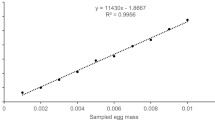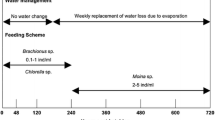Abstract
The embryonic and larval development of volitionally spawned eggs of the serranid fish Marcia’s anthias, Pseudanthias marcia (Randall and Hoover 1993) is described and illustrated based on observations during spawning, hatching and larval rearing trials. Eggs were obtained from volitional spawning of P. marcia under captive conditions in Re-circulating Aquaculture System (RAS) in which the sea water is re - circulated at the rate of 1500 L per hour. Fertilized eggs of P. marcia were pelagic, non adhesive, transparent and measured 617.891 ± 14.9 μ (mean ± SD). Each egg had a single oil globule which measured in 125.866 ± 14.06 μ (mean ± SD).Cell division or two cell stage started forming after 14 min of collection of the fertilized eggs from the brood stock tank. Larval motility began after 14:30 h and hatching occurred after 14:50 h at 29 °C. Average total length of the newly hatched larvae was 1206.55 ± 100.02 μ and the yolk sac length was 826.00 ± 46.00 μ. On 3rd dph (days post hatch), the total length of the larvae was 1906.26 ± 32.3 μ. Pigmentations patterns were observed in freshly hatched larvae after 4 h of hatching, with the presence of eight pigmented areas on the dorsal surface of the larva and one spot on the posterior tip of the yolk sac. Notochord flexion stage was complete on 25 dph (TL- 4.85 mm). Between 32 and 34 dph larvae metamorphosed to adult shape. Adult coloration and forked caudal fin shape was observed after 50 days of post hatch and the total body length of the larvae was 42–43 mm.




Similar content being viewed by others
References
Allen GR (2005). Appendix 4, list of the reef fishes of Madagascar, in: McKenna, S. a., Allen, G. R. (Eds.), a rapid marine biodiversity assessment of Northwest Madagascar. Conservation International, Washington, D.C. Bulletin of the Rapid Assessment, 31, pp.102–124
Anil MK, Santhosh B, Prasad BO, George RM (2012) Broodstock development and breeding of black-finned anemone fish Amphiprion nigripes Regan, 1908 under captive conditions. Indian Journal of Fisheries 59(1):77–82
Anil MK, Gomathi P, Raheem PK, Raju B, Philipose KK, Gopalakrishnan A (2018) Captive brood stock development, breeding and seed production of Anthid fish (family: Serranidae) Marcia's anthias,Pseudanthias marcia in recirculation aquaculture system (RAS). Aquaculture 492:265–272. https://doi.org/10.1016/j.aquaculture.2018.03.043
Brinley FJ (1939). Spawning habits and development of Beaugregory (Pomacentrus leucostictus). Copeia, 185–188. https://doi.org/10. 2307/1436876
Brooks S, Tyler CR, Sumpter JP (1997) Egg quality in fish: what makes a good egg? Reviews in Fish Biology & Fisheries 7:387–416. https://doi.org/10.1023/A:1018400130692
Chen ZSL, Ye XSH (2003) Establishment of a pluripotent embryonic cell line from sea perch (Lateolabrax japonicus) embryos. Aquaculture 218(1–4):141–151. https://doi.org/10.1016/S0044-8486(02)00570-7
Chng CL, Senoo S (2008) Egg and larval development of a new hybrid grouper ,Tiger grouper Epinephelus fuscoguttatus x Giant grouper Epinephelus lanceolatus. Aquaculture science 56(4):505–512
Coward K, Bromage NR, Hibbitt O, Parrington J (2002) Gamete physiology, fertilization and egg activation in teleost fish. Rev Fish Biol Fish 12:33–58
DeTolla LJ, Srinivas S, Whitaker BR, Andrews C, Hecker B, Kane AS, Reimschuessel R (1995) 1995. Inst Lab Anim Res J 37(4):159–173. https://doi.org/10.1093/ilar.37.4.159
Doi M, Munir MN, Nik-Razali NL, Zulkifli T (1991) Artificial propagation of the grouper, Epinephelus suillus, at the Marine Finfish Hatchery in Tanjong Demong, Terengganu, Malaysia, Kertas Pengembangan Perikanan Bil,167 ,1–41
Duray MN, Estudillo CB, Alpasan LG (1997) Larval rearing of the grouper Epinephelus suillus under laboratory conditions. Aquaculture 150:63–76. https://doi.org/10.1016/S0044-8486(96)01467-6
García-Ortega A, Daw A, Hopkins K (2013). Feeding hatchery-produced larvae of the giant grouper, Epinephelus lanceolatus. In: Conference: Hatchery Technology for high Quality Juvenile Production: Proceedings of the 40th U.S.-Japan Aquaculture Panel Symposium, At: Honolulu, Hawaii, USA, volume: U.S. Dept. commerce, NOAA Tech. Memo. NMFS-F/SPO
Glamuzina B, Glavic N, Tutman P, Kozul V, Skaramuca B (2000) Egg and early larval development of laboratory reared gold blotch grouper, Epinephelus costae (Steindachner, 1878) (Pisces, Serranidae). Sci Mar 64:341–345
Glamuzina B, Skaramuca B, Glavic N, Kozul V (1998) Preliminary studies on reproduction and early life stages in rearing trials with dusky grouper, Epinephelus marginatus (Lowe, 1834). Aquac Res 29:769–771. https://doi.org/10.1046/j.1365-2109.1998.29100769.x
Goulet D (1995) Temporal patterns of reproduction in the Red Sea damselfish Amblyglyphidodon leucogaster. Bull Mar Sci 57:582–595
Heemstra E, Heemsptra P, Smale M, Hooper T, Pelicier D (2004) Preliminary checklist of coastal fishes from the Mauritian island of Rodriguez. J Nat Hist 38:3315–3344
Heemstra PC, Heemstra E (2004). Coastal fishes of southern Africa.NISC and SAIAB.I-xxiv + 1-488
Heemstra PC, Akhilesh KV (2012) A review of the anthiine fish genus Pseudanthias (Perciformes: Serranidae) of the western Indian Ocean, with description of a new species and a key to the species. International Journal of Ichthyology 18(3):121–164
Hirst A, López-Urrutia A (2006) Effects of evolution on egg development time. Marine Ecological Progress Series 326:29–35
Holt GJ (2003) Research on culturing the early life history stages of marine ornamental species. In: Cato, J.C., Brown, C.L.(Eds.), marine ornamental species: collection, culture and conservation. Iowa state press. 251–254
Hussain NA, Higuchi M (1980) Larval rearing and development of the brown-spotted grouper, Epinephelus tauvina (Forskal). Aquaculture 19:339–350. https://doi.org/10.1016/0044-8486(80)90082-4
James CM, Al-Thobaiti SA, Raseem BM, Carlos MH (1997) Breeding and larval rearing of the camouflage grouper Epinephelus polyphekadion (Bleeker), in the hypersaline waters of the Red Sea coast of Saudi Arabia. Aquac Res 28:671–681. https://doi.org/10.1046/j.1365-2109.1997.00908.x
Kendall AW, Ahlstrom EH, and Moser HG (1984). Early life history stages of fishes and their characters. In: H.G. Moser, W.J. Richards, D.M. Cohen, M.P. Fahay, a.W. Kendall and S.L. Richardson (editors), ontogeny and systematics of fishes, international Symposium dedicated to the memory of Elbert Halvor Ahlstrom, La Jolla, California, 15-18 august 1983. Am. Sot. Ichth. Herbs, spec. Publ. No. 1, Allen Press Inc., Laurence, USA, 11-24
Kitajima C, Takaya M, Tsukashima Y, Arakawa T (1991) Development of eggs, larvae and juveniles of the grouper, Epinephelus septemfasciatus, reared in laboratory. Japanese Journal of Ichthyology 38:47–55
Leu MY, Liou CH, Fang LS (2005) Embryonic and larval development of the Malabar grouper, Epinephelus malabaricus (Pisces: Serranidae). Journal of Marine Biological Association of the United Kingdom 85:1249–1254
Leu MY, Sun YH, Meng PJ (2015) First results of larval rearing and development of the bluestriped angelfish Chaetodontoplus septentrionalis (Temminck & Schlegel) from hatching through juvenile stage with notes on its potential for aquaculture. Aquaculture Research 46:1087–1110. https://doi.org/10.1111/are.12265
Lim LC (1993) Larvi culture of the greasy grouper Epinephelus tauvina and brown-marbled grouper E. fuscoguttatus in Singapore. Journal of World Aquaculture Society 24:262–274
Moorhead JA, Zeng C (2010) Development of captive breeding techniques for marine ornamental fish: a review. Rev Fish Sci 18(4):315–343
Myrberg A Jr, Brahy D, Emery AR (1967) Field observations on the reproduction of the damselfish, Chromis multilineata (Pomacentridae) with additional notes on general behaviour. Copeia 4:819–827
Nazar A, Hussain H (1980) Larval rearing and development of the brown spotted grouper , Epinephelus tauvina (Forskal). Mariculture and Fisheries Department, Kuwait Institute for Scientific Research, Aquaculture, 19, 339–350
Olivotto I, Leu MY, Blázquez M (2017) Life cycles in marine ornamental species - fishes as a case. In: Calado R, Olivotto I, Planas M, Holt GJ (eds) Marine ornamental species aquaculture. John Wiley & Sons Ltd., West Sussex, pp 23–49. https://doi.org/10.1002/9781119169147.ch3
Porazinski SR, Wang H, Furutani-Seiki M (2010) Dechorionation of Medaka embryos and cell transplantation for the generation of chimeras. Journal of Visualized Experiment, 46, 1–4, http://www.jove.com/details.php?id=2055, doi: https://doi.org/10.3791/2055
Powell AB, Tucker JW Jr (1992) Egg and larval development of laboratory-reared Nassau grouper, Epinephelus striatus (Pisces, Serranidae). Bull Mar Sci 50:171–185
Rahman MM, Miah MI, Taher MA, Hasan MM (2009) Embryonic and larval development of guchibaim, Mastacembelus pancalus (Hamilton). Journal of Bangladesh Agricultural University 7(1):193–204
Randall JE, Hoover JP (1993) Pseudanthias marcia, a new serranid fish from Oman. Revue Françaisd’Aquariologie 1993(20):47–52
Randall JE, Pyle RL (2001) Four new serranid fishes of the anthiine genus Pseudanthias from the South Pacific. Raffles Bulletin of Zoology 49(1):19–34
Randall JE, Heemstra PC (2006) Review of the indo-Pacific fishes of the genus Odontanthias (Serranidae: Anthiinae), with descriptions of two new species and a related genus. Indo-Pacific Fishes 38:1–32
Rasem BM, James CM, Al-Thomaiti SA, Carlos MH (1997) Spawning of the camouflage grouper, Epinephelus polyphekadion (Bleeker) in the hyper saline waters of Saudi Arabia. Asian Fisheries Science 9:251–259
Rohini Krishna MV, Anil MK, Neethu Raj P, Santhosh B (2016) Seed production and growth of Neopomacentrus cyanomos (Bleeker, 1856) in captivity. Indian Journal of Fisheries 61(3):50–56
Sawada Y, Kato K, Okada T, Kurata M, Mukai Y, Miyashit S, Murata O, Kumai H (1999) Growth and morphological development of larval and jevenile Epinephelus bruneus (Perciformes: Serranidae). Ichthyol Res 46:245–257. https://doi.org/10.1007/BF02678510
Tamaru CS, Carlstromtrick C, Fitzgerald WJ and Ako H (1996) Induced final maturation and spawning of the marbled grouper, Epinephelus microdon captured from spawning aggregations in the Republic of Palau, Micronesia Journal of World Aquaculture Society, 27 (4), 363–372
Tucker, JW Jr (1991) Induced spawning and culture of Nassau grouper, Epinephelus striatus. (abstract). Journal of World Aquaculture Society, 22 (3), 60A
Ukawa M, Higuchi M, Mito S (1966) Spawning habits and early life history of a serranid fish, Epinephelusakaara (Temmincket Schlegel). Japanese Journal of Ichthyology 13:156–161
Wolf K, Ahne W (1982) Fish cell culture. In: advances in cell culture Marmorosh K. (ed.) academic press, New York. 2, 305-328
Watanabe WO, Ellis SC, Ellis EP, Head WD, Kelley CD, Moriwake A, Lee CS, Bianfang PK (1995) Progress in controlled breeding of Nassau grouper (Epinephelus striatus) broodstock by hormone induction. Aquaculture 138:205–219
Yoseda K, Dan S, Sugaya T, Yokogi K, Tanaka M, Tawada S (2006) Effects of temperature and delayed initial feeding on the growth of Malabar grouper (Epinephelus malabaricus) larvae. Aquaculture 256:192–200. https://doi.org/10.1016/j.aquaculture.2006.01.031
Acknowledgements
This research work was carried out with the funding from Indian council of Agricultural Research (ICAR) AINP1007134 under the project entitled “All India Net work Project on Mariculture (AINP-M)” in the hatchery of Vizhinjam Research center of ICAR-CMFRI Trivandrum, Kerala. The authors are thankful to all the staff members of Vizhinjam Research.
Centre for their cooperation and support.
Availability of Data and Materials
The datasets supporting the conclusions of this article are available.
Author information
Authors and Affiliations
Contributions
P. Gomathi conceived the study and wrote the manuscript, M. K. Anil has designed the rearing system(RAS), P.K Raheem collected the data and performed the experiments, P. Neethu Raj analyzed the data, M.V Rohini Krishna assisted in manuscript preparation, Ambarish P.Gop has maintained the broodstock of fishes and S.Surya has collected eggs for the study. All the authors read and approved the final manuscript.
Corresponding author
Ethics declarations
Competing Interests
The authors declare that they have no competing interests.
Additional information
Publisher’s Note
Springer Nature remains neutral with regard to jurisdictional claims in published maps and institutional affiliations.
Rights and permissions
About this article
Cite this article
P, G., K, A.M., K, R.P. et al. Egg and Larval Development of Serranid Fish Marcia’s Anthias, Pseudanthias marcia (Subfamily: Anthiinae) Spawned and Reared under Captive Condition. Thalassas 36, 23–31 (2020). https://doi.org/10.1007/s41208-020-00193-0
Received:
Revised:
Published:
Issue Date:
DOI: https://doi.org/10.1007/s41208-020-00193-0




